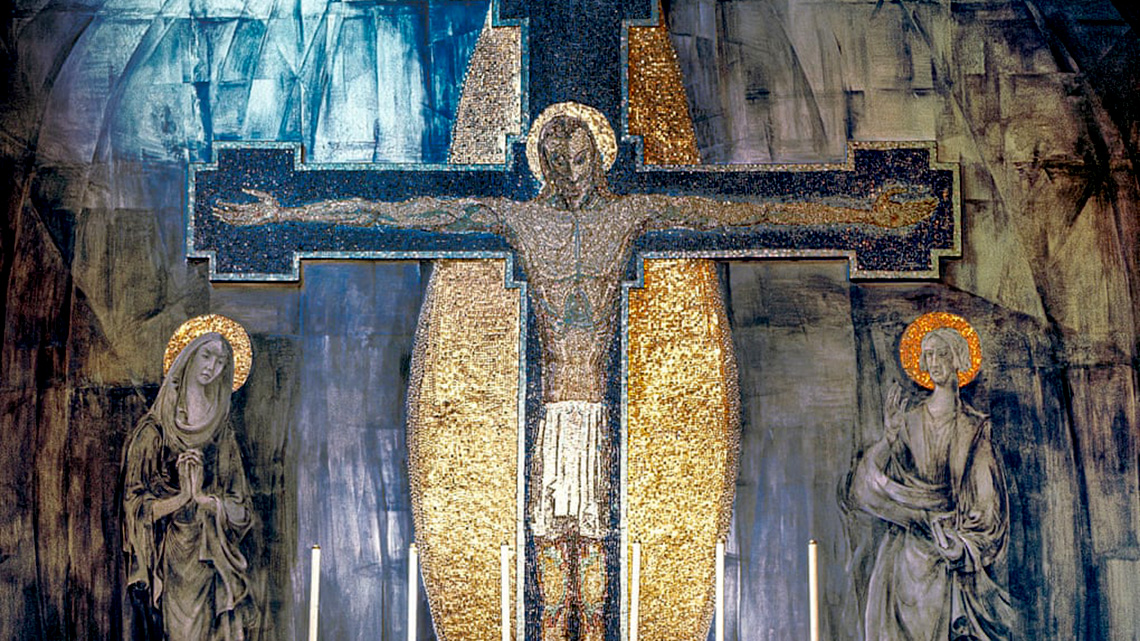
Following a long campaign led by SAVE Britain’s Heritage, the government has added the ‘Oldham Mural’ masterpiece to its national heritage register – listed at Grade II.
Titled ‘The Crucifixion’, the post-WWII mural was completed in 1955 by Hungarian artist George Mayer-Marton and was designed for the Church of the Holy Rosary in Oldham. The church, on the edge of the town, is owned by the Diocese of Salford but closed in 2017 leaving the mural vulnerable to decay and vandalism.
The 7.5m long mural depicts the figure of Christ in golds and tans against a dark blue cross and gold mandorla. It was commissioned following the Festival of Britain when public art came to be seen as a symbol of civic renewal and social progress.
Sophie Andreae, Vice Chair of the Bishops’ Conference Patrimony Committee, said:
“The George Mayer-Marton mural in Oldham’s Holy Rosary Church is of great importance. The listing recognises this. The Patrimony Committee looks forward to working with Salford Diocese, and all interested parties, to ensure the protection and proper conservation of this outstanding artwork. This is now urgent.”
In 2017, an application to list the mural was rejected as it was thought to no longer be intact as the fresco part of the mural had been painted over and the mosaic haloes of Mary and St John removed. However, over the last five years, tests have shown that the original fresco remains in good condition beneath the paint, which has led to the highly unusual and possibly unique mural being listed.
The new List entry describes the striking aesthetic combination of neo-Byzantine mosaic and modernist Cubist-influenced fresco inventively applied to traditional Christian iconography in a deeply personal evocation of suffering and redemption.
The artist, Hungarian-born George Mayer-Marton, was one of a generation of talented artists who came to Britain following Nazi persecution. His great nephew, Nick Braithwaite, warmly welcomed the listing:
“I am delighted this masterpiece of exceptional significance is finally receiving the national recognition it deserves. I am grateful to everyone who has helped get us here and especially to SAVE Britain’s Heritage for keeping the mural in the spotlight.”
The Grade II Listing was made by the Department for Digital, Culture, Media & Sport (DCMS) on the recommendation of Historic England.
Heritage Minister Nigel Huddleston said:
“This stunning mural in the Church of the Holy Rosary deserves to be listed at Grade II. This will protect the one-of-a-kind mural and serve as an important reminder for future generations of Hungarian artist George Mayer-Marton’s escape from Nazi persecution.”
Campaigning to protect the mural, SAVE Britain’s Heritage galvanised support from galleries and museums that hold works by Mayer-Marton including the Victoria Gallery in Liverpool and the Glynn Vivian Gallery in Swansea as well as the Imperial War Museum.
The campaign was also supported by the directors of world-famous art museums including Tristram Hunt at the Victoria & Albert Museum, who praised the mural’s “dazzling beauty”, as well as Gabriele Finaldi at the National Gallery in London, László Baán at Budapest’s Museum of Fine Arts and Harald Krejci at the Belvedere in Vienna.
Henrietta Billings, director of SAVE Britain’s Heritage, said:
“This is a fantastic result for Oldham, and modern public art in England. We’re delighted that the mural will now be celebrated and finally given the recognition it deserves. Listing will open up a new chapter for this building and artwork and we look forward to helping the Diocese of Salford to find a new and sympathetic owner.”
“The Crucifixion” prior to the fresco part of the mural being painted over.
© Nick Braithwaite / George Mayer-Marton Estate